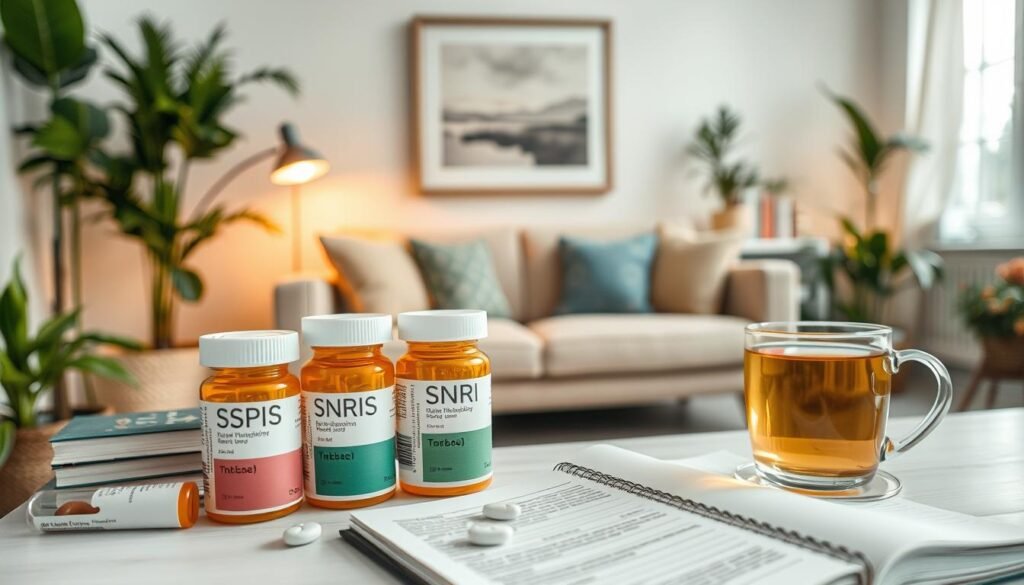Did you know about 60% to 75% of people feel better using Selective Serotonin Reuptake Inhibitors (SSRIs)? They help with major depressive disorder and anxiety disorders. That means SSRIs are often chosen as the go-to antidepressants in America. As we pay more attention to mental health, knowing the different medications is key. This includes SSRIs, Serotonin-Norepinephrine Reuptake Inhibitors (SNRIs), and benzodiazepines. Each type serves a unique purpose and has its own benefits and possible side effects.
This article sheds light on SSRIs, SNRIs, and benzodiazepines. It covers what they do, common uses, possible side effects, and what to think about if you’re considering them for your mental health.
Key Takeaways
- SSRIs are commonly used for major depressive disorder and anxiety disorders.
- SNRIs are effective alternatives that impact serotonin and norepinephrine levels.
- Benzodiazepines act as fast-acting anti-anxiety medications.
- Open communication with healthcare providers is crucial for effective treatment.
- Understanding medication interactions can significantly reduce the risk of adverse effects.
Understanding SSRIs and Their Uses
Selective Serotonin Reuptake Inhibitors, known as SSRIs, are a top choice for treating mood disorders. They are especially good for depression and anxiety. These medications work by boosting serotonin in the brain, which helps improve mood.
What Are SSRIs?
SSRIs are drugs that help increase serotonin, a key mood balancer. This boost in serotonin helps with emotional stability. It reduces depression and anxiety symptoms, making SSRIs vital in mental health care.
How SSRIs Affect Serotonin Levels
SSRIs block the reabsorption of serotonin. This means more serotonin stays active in the brain, helping with mood. Common SSRIs include fluoxetine (Prozac), sertraline (Zoloft), and others. These drugs combat mood disorder symptoms by acting on serotonin pathways.
Common SSRIs on the Market
Many SSRIs have the FDA‘s approval to fight depression and other mood issues. Below is a table showing some top SSRIs:
| Medication | Indication | Dosage Information |
|---|---|---|
| Citalopram (Celexa) | Major depressive disorder | Maximum dose of 40mg/day; 20mg for those over 60 |
| Escitalopram (Lexapro) | Generalized anxiety disorder | Recommended starting dose is 10mg/day |
| Fluoxetine (Prozac) | Major depressive disorder | Typical dose ranges from 20 to 60mg/day |
| Paroxetine (Paxil) | Social anxiety disorder | Usual range is 10 to 60mg/day |
| Sertraline (Zoloft) | Panic disorder | Common starting dose is 50mg/day |
Talking openly with healthcare providers is key when considering SSRIs. Regular check-ins are important to manage effectiveness and side effects. For detailed info on SSRIs, read this article.
Exploring SNRIs: A Close Cousin to SSRIs
SNRIs, or Serotonin-Norepinephrine Reuptake Inhibitors, are similar to SSRIs. They target both serotonin and norepinephrine neurotransmitters. This approach can offer better relief for anxiety disorders and major depression than SSRIs alone. Knowing about SNRIs helps in choosing the right treatment option.
What Are SNRIs?
SNRIs are key in treating mental health issues. They boost mood and emotional well-being by increasing serotonin and norepinephrine in the brain. These medications are often effective for anxiety disorders when SSRIs don’t work well enough.
Differences Between SSRIs and SNRIs
SSRIs and SNRIs differ mainly in their targets. SSRIs focus on serotonin only. SNRIs impact both serotonin and norepinephrine. This can lead to better management of symptoms for some people. Comparing SSRIs and SNRIs can help find the best treatment fit.
Popular SNRIs and Their Indications
There are a few SNRIs known for their success in treating anxiety and depression. Notably:
| Medication | Indications |
|---|---|
| Venlafaxine (Effexor XR) | Generalized Anxiety Disorder, Major Depression |
| Duloxetine (Cymbalta) | Generalized Anxiety Disorder, Neuropathic Pain |
| Desvenlafaxine (Pristiq) | Major Depression, Anxiety |
Benzodiazepines: Fast-Acting Anti-Anxiety Medications
Benzodiazepines are a group of drugs known for their quick relief of anxiety. They are often chosen by people who need rapid help with their anxiety symptoms. Learning about benzodiazepines can help people make better choices for their mental health care.
What Are Benzodiazepines?
Benzodiazepines are drugs for treating anxiety and panic disorders. They work by boosting the effects of GABA, a substance in the brain that calms it down. This leads to fast reduction of anxiety. However, they can be addictive and have side effects.
How Benzodiazepines Work
To understand benzodiazepines, it’s important to know how they interact with GABA. They enhance GABA’s effect, quickly easing anxiety and panic. They are best used for urgent situations. Still, it’s key to use them under a doctor’s care to avoid addiction.
Commonly Prescribed Benzodiazepines
There are many benzodiazepines prescribed for quick anxiety relief. Some of these include:
- Alprazolam (Xanax)
- Lorazepam (Ativan)
- Diazepam (Valium)
- Clonazepam (Klonopin)
These drugs often support treatment for generalized anxiety disorder and other conditions. They’re usually combined with antidepressants for better results.
| Benzodiazepine | Brand Name | Common Uses |
|---|---|---|
| Alprazolam | Xanax | Anxiety disorders, panic attacks |
| Lorazepam | Ativan | Insomnia, anxiety relief |
| Diazepam | Valium | Muscle spasms, anxiety, alcohol withdrawal |
| Clonazepam | Klonopin | Panic disorder, anxiety |
Benzodiazepines work well for quick anxiety relief, but they have risks. It’s very important to talk to a doctor when considering them. A healthcare provider can help decide the best treatment plan.
SSRIs, SNRIs, Benzodiazepines: What You Need to Know
Choosing the right medication for anxiety and depression is based on many factors. This includes the type of symptoms and how long treatment is needed. SSRIs, SNRIs, and benzodiazepines each play a different role in mental health care. They each have their own way of treating issues.
Key Differences in Treatment Approach
SSRIs are often the first choice for treating long-lasting anxiety and depression. They change serotonin levels in the brain, which may start showing benefits after six weeks. If SSRIs don’t help enough, SNRIs are the next option. They affect serotonin and norepinephrine levels. Benzodiazepines are used for quick relief of acute anxiety but can lead to dependence.
When to Use Each Medication
SSRIs are best for ongoing treatment of anxiety and depression. Benzodiazepines are for short-term use, treating sudden anxiety or acute symptoms. However, they have risks like side effects and dependency. SNRIs are used when SSRIs don’t work, especially for continuous treatment. It’s important to also consider therapy, like cognitive behavioral therapy, early on.
Combining SSRIs with Benzodiazepines
Sometimes, medications are combined to improve results. A benzodiazepine can be used with an SSRI for quick anxiety relief. This helps while waiting for the SSRI to take full effect. By doing this, immediate and long-term mental health goals are met effectively.
| Medication Class | Main Use | Benefits | Risks |
|---|---|---|---|
| SSRIs | Long-term management of anxiety and depression | Effective for OCD, PTSD; less dependency risk | Possible nausea, insomnia, weight changes |
| SNRIs | Long-term management if SSRIs are ineffective | Balances serotonin and norepinephrine | Similar side effects to SSRIs |
| Benzodiazepines | Short-term relief for acute anxiety | Fast-acting relief from anxiety | High potential for abuse, sedation, fall risk |
Common Side Effects of SSRIs, SNRIs, and Benzodiazepines
It’s important to know about medication side effects if you’re exploring treatment options. SSRIs and SNRIs are common antidepressants with several side effects. Understanding these can help manage mental health more effectively.
SSRIs Side Effects
SSRIs have several side effects like:
- Upset stomach
- Headaches
- Insomnia
- Sexual dysfunction
These side effects often become less intense over time. However, increased anxiety is possible early in treatment. This is especially true for those under 25, who may face a higher risk of suicidal thoughts.
SNRIs Side Effects
SNRIs have similar side effects to SSRIs, plus a few others, including:
- Nausea
- Increased blood pressure
- Heightened anxiety
SNRIs may also cause a rapid heart rate, aside from the common effects seen with SSRIs. Knowing these side effects is crucial for managing treatment.
Benzodiazepines Side Effects
For short-term anxiety, benzodiazepines work well, but they have side effects such as:
- Drowsiness
- Memory problems
- Coordination issues
Older adults may find these effects more severe. There’s also a risk of tolerance and dependence with long-term use. This makes understanding and caution essential.
Potential Interactions with Other Prescription Drugs
Understanding how different medications can interact is very important. It keeps patients safe. SSRIs and SNRIs may react with other drugs. This could change how treatments work or lead to serious side effects. When benzodiazepines are involved, careful monitoring is needed. This is especially true if they’re taken with other drugs that depress the central nervous system or certain antidepressants.
SSRIs and Drug Interactions
SSRIs can affect many other medications. This might cause negative reactions or change how treatments work. Mixing SSRIs with drugs like warfarin can make bleeding more likely. Combining them with tricyclic antidepressants may increase serotonin levels too much. This brings a higher risk of serotonin syndrome. Also, SSRIs like fluoxetine and paroxetine can slow the breakdown of some benzodiazepines. This might make the sedation stronger and requires extra caution.
SNRIs and Their Interaction Risks
SNRIs have their own risks when mixed with other drugs. For instance, taking SNRIs with NSAIDs could lead to more stomach bleeding. Being cautious is also needed when SNRIs are taken with monoamine oxidase inhibitors (MAOIs). This combination could cause a very high blood pressure crisis. Knowing about these risks is key to managing treatments well.
Benzodiazepines: What to Avoid
With benzodiazepines, avoiding certain combinations is a must. Mixing them with alcohol or other drugs that depress the central nervous system could cause deep sedation or breathing problems. Patients must tell their doctors about all the medicines they use. This helps in spotting possible drug interactions. It also makes sure the right precautions are taken with benzodiazepines. Good communication helps in making treatments safer.

| Medication Type | Potential Interactions | Precautions |
|---|---|---|
| SSRIs | Warfarin, Tricyclics, NSAIDs, MAOIs | Monitor bleeding risks, avoid MAOIs, assess interactions with CNS depressants |
| SNRIs | NSAIDs, MAOIs | Monitor for gastrointestinal bleeding, avoid MAOIs |
| Benzodiazepines | Alcohol, CNS depressants | Avoid combinations that increase sedation risks |
Long-Term Use vs. Short-Term Use Considerations
Understanding how anxiety medications work is important. It helps us see why long-term and short-term treatments are different. Long-term vs short-term considerations play a big role in choosing a treatment plan.
Are SSRIs Safe for Long-Term Use?
Doctors often prescribe SSRIs for anxiety and depression. They are seen as safe for the long haul. They bring mental health benefits and have a low risk of addiction. It takes about six weeks to see SSRIs’ full effects, but their benefits last a long time without leading to addiction. New guidelines say they are a top choice because they work well and are safe for continuing treatment.
Risks of Long-Term Benzodiazepine Use
On the other hand, using benzodiazepines for a long time has its dangers. While they work quickly, they come with risks like addiction, withdrawal, and memory problems. Studies show that staying on them can cause issues, including dementia and trouble moving. So, people who need them for ongoing anxiety care must be watched closely.
Management Strategies for Long-Term Users
If you need treatment for a long time, having a good plan is key. Slowly stopping benzodiazepines helps prevent withdrawal. Adding talk therapy offers a more complete treatment. Building a strong support network and tweaking medication doses give patients care that meets their unique needs. These steps help manage the risks of both long-term SSRIs and short-term benzodiazepines use.
| Medication Type | Duration of Effect | Risks | Benefits |
|---|---|---|---|
| SSRIs | 6 weeks for full effects | Low risk of dependence | Safe for long-term use |
| Benzodiazepines | 30-60 minutes | High risk of dependence | Fast-acting relief |
Psychotherapy and Medication: A Comprehensive Treatment Plan
Finding the right way to treat anxiety and depression is key. Medication and psychotherapy together form a strong treatment plan. This method tackles both symptoms and causes of mental health issues.
Cognitive-Behavioral Therapy (CBT) is very effective for anxiety. It helps people cope better and become more resilient.
Medications can reduce symptoms for people with generalized or social anxiety. Drugs like SSRIs and SNRIs are typically suggested first. It’s important to customize treatment plans for each patient’s needs.
Studies show combining therapy and medication works best. Patients often get better when they use both treatments together. For more information, check this detailed resource.

Transforming Mental Health Treatment: The Role of Medication
Medication plays a key role in managing mood disorders. It aids in improving mental health. Medicines like SSRIs and SNRIs are important. They adjust brain chemicals to ease anxiety and depression.
Understanding how medication works is crucial. It helps patients see their treatment options clearly.
Importance of Medication in Managing Mood Disorders
Medications are used to treat anxiety, depression, and OCD. They balance brain chemicals to relieve symptoms. SSRIs focus on serotonin, while SNRIs impact serotonin and norepinephrine. Treatment often lasts over 12 months.
Knowing the pros and cons of medications is vital. Some can boost antidepressants’ effects, but others might increase risks like suicidality. Talking with healthcare providers helps in making educated treatment choices.
Effectiveness of Cognitive Behavioral Therapy
Cognitive Behavioral Therapy (CBT) works well with medication. It offers techniques to change behavior and cope better. CBT’s success in treating anxiety and mood disorders is proven. It tackles harmful thought patterns and boosts activity.
Therapy can improve medication’s benefits. By engaging in meaningful activities recommended in CBT, individuals can significantly enhance their mental health. For more on CBT techniques, visit CBT Techniques for Anxiety.
Consulting with Healthcare Providers
Talking openly with healthcare providers is vital for handling anxiety and getting the right treatment. It’s important for patients to share their thoughts, feelings, and what they expect. This builds trust and helps create a plan that meets their needs.
Essential Questions to Ask Your Doctor
When meeting with doctors, having a list of questions for doctor about mental health is useful. Key questions might be:
- What medication options are available for my specific symptoms?
- What are the potential side effects of these medications?
- Are there alternative treatments I should consider?
- How do I deal with side effects?
- What if a medication isn’t working?
Asking these things helps patients understand their options and decide on their treatment. For tips on talking to mental health experts, checking out finding the right professional help is helpful.
Importance of Open Communication
Being open in treatment discussions is crucial for mental health care. Patients should feel at ease mentioning any new symptoms, side effects, or worries about their treatment. This ensures that care matches their health history and lifestyle.
Regular talks with healthcare providers help track progress and tweak treatment if needed.

Conclusion
Using SSRIs, SNRIs, and benzodiazepines together is key in treating anxiety and depression. These meds are vital because they target the brain’s mood centers. Also, studies show these drugs can influence how we make decisions and see fairness, showing their big effect on mental health.
Taking medication alone might not be enough, though. Adding therapy to the mix can really help people with mood disorders. It’s really important to keep talking to doctors to make sure the treatment is just right. This way, people get the best care for their specific needs.
People dealing with mood disorders should play an active role in their treatment. This helps them build the skills they need for a better life. They can become stronger and greatly improve their well-being.